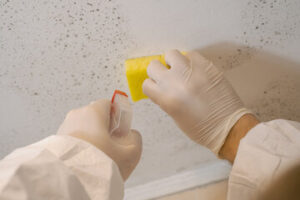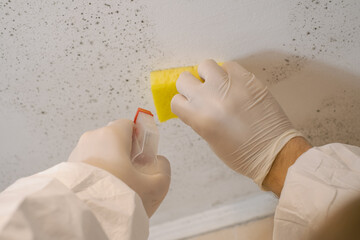Mold Removal Provo is a process that reduces the number of mold spores to normal levels. Spores will always exist, but they should not grow if the moisture problem is resolved.
To clean the mold, workers should wear gloves and a mask to avoid breathing in spores. A 3% solution of hydrogen peroxide or undiluted vinegar can be used to kill the mold.
Mold removal can be a very costly undertaking. It is important to get a thorough quote and understand all the potential costs before hiring a contractor. The cost of the remediation will vary depending on the size of the mold infestation and where it is located in the home. In addition, there may be associated expenses like structural repairs or cleaning costs. Some companies may charge by the square foot or may include services like inspection, remediation and cleaning, and restoration in their pricing.
The cost of mold removal can be even higher if the spores are invasive or toxic. For example, the fungus Stachybotrys chartarum, commonly known as black mold, is difficult to remove and can cause serious health problems. This type of mold thrives in moist, humid areas and is often found in attics or behind walls. Black mold is especially difficult to clean and requires special equipment. The cost of this type of remediation can run into thousands of dollars.
It is also important to remember that mold removal will not always be covered by insurance. The National Flood Insurance Program offers an endorsement for mold damage, but the coverage is limited. Some private insurance companies offer coverage, but it is important to check with your insurer before you make a claim.
If you have a small area of mold, you can save money by getting a home inspection and fixing the water problem before the mold spreads. It is also a good idea to install an air filtration system and keep moisture levels low. This will help prevent the recurrence of the problem and lower the cost of remediation.
Many homeowners choose to hire a professional for mold removal. However, it is important to consider the safety of your family before making this decision. The initial symptoms of exposure to mold may be minor, such as sneezing and itching. More severe symptoms can include nausea, fatigue, and respiratory distress. In some cases, prolonged exposure can cause a number of serious conditions, including memory loss and cognitive problems. It is important to seek medical attention if you have any of these symptoms.
Methods
Mold thrives in damp and shaded areas, such as behind walls and under cabinets. It can pose a health risk, especially for those with asthma or weakened immune systems. Hidden mold can also compromise indoor air quality and lead to structural damage. It is important to understand how to remove mold from walls and prevent future growth.
The first step is determining the source of the problem. Leaks, condensation, and poor ventilation can all lead to moisture problems. Once the problem is identified, it should be repaired and the area dried to prevent mold from returning.
A swab test is a quick and inexpensive method of identifying the type of mold that is growing on your wall. Use a sterile swab to collect a sample from the visible mold patch and place it in a sealed bag for analysis. You can also lift a sample using clear adhesive tape, which can be placed on a microscope slide for further analysis.
The next step is determining the extent of the problem. If the mold covers less than 10 square feet, you can manage it with basic DIY cleaning methods. If the mold is more widespread, you should seek professional advice.
If the mold is a serious problem, you may need to remove porous materials such as drywall and wood. You may also need to replace carpeting and padding, and remove and replace affected insulation. The contaminated material will then need to be disposed of safely.
During the cleaning process, you should always wear protective clothing and eyewear to protect yourself from mold spores. In addition, you should work in small sections to ensure thorough coverage and prevent spreading mold spores.
There are many different methods for removing mold, but the most important factor is addressing the underlying cause. A trained mold removal expert can help identify the source of the mold and recommend a course of action to resolve it. They can also provide a detailed inspection report on the findings and recommendations for remediation. They can even perform a thorough air-quality assessment using HEPA filters and negative pressure to reduce the number of mold spores in your home.
Preparation
Before mold removal begins, it is important to prepare the work area. This includes wearing protective gloves and a face mask to avoid direct contact with mold spores. In addition, the work area should be sealed off to prevent spores from spreading to other areas of the home. The area should also be well-ventilated. This can be accomplished by opening windows and using a fan in the room.
It is also important to choose cleaning products that are safe for use in a mold-infested environment. This includes using a cleaning solution that is designed to remove mold without damaging the surface. In general, these cleaners contain bleach, borax, vinegar, hydrogen peroxide, ammonia, or detergent solutions. It is also important to follow the manufacturer’s instructions when using these chemicals.
If the mold is on painted or non-porous surfaces, you can simply scrub it away with a brush or sponge. If it is on drywall, however, you may need to cut out and replace the affected section. Once the area has been cleaned, it is important to wipe down all surfaces and dry them thoroughly. This will help prevent the regrowth of mold.
When scrubbing a surface, it is best to work in small sections. This will prevent spreading mold spores to other areas of the room. It is also a good idea to rinse the sponge or brush frequently with clean water. This will ensure that any mold spores are removed and that the clean surface is not contaminated with water or cleaning solution residue.
It is also important to dispose of any items that have been contaminated by mold growth. This can include furniture, clothing, and even structural materials like drywall. These items should be placed in a sealable plastic bag and stored away from the rest of the house. Finally, it is important to use a dehumidifier and fan in the work area to reduce moisture levels and humidity. Mold spores thrive in moist and humid environments, so this step will help prevent future outbreaks. It is also a good idea to conduct air and surface tests after the cleanup is complete.
Safety
Mold is dangerous and should only be handled by trained personnel. This is especially important if the mold is toxic black mold, which produces very harmful spores. During mold removal, workers should wear disposable protective clothing and respirators that fit tightly and filter out harmful spores. They should also use a decontamination room before and after entering the affected area. This will prevent cross-contamination and limit the spread of the spores to other parts of the building.
To protect the health of the building’s occupants, it’s important to determine the cause of the mold growth and address it. Insufficient airflow and water-damaged materials are common causes of mold growth, and resolving these problems can reduce future outbreaks. It’s also helpful to perform regular inspections of the property for signs of mold. This will help catch small colonies before they become a serious health concern.
In addition to preventing mold damage, these inspections can help find hidden moisture sources. Moisture will usually cause mold to grow if it is not removed quickly, so it’s essential to fix leaky spots and improve insulation in damp areas.
It’s also important to note that mold spores are a natural component of our environment and cannot be entirely eliminated. The best way to minimize spores is to ensure proper ventilation and humidity control, especially in the basement and attic.
Some items can be salvaged after a mold infestation, but it’s vital to take safety measures when dealing with such items. Items that contain porous materials, such as furniture and antique rugs, should be disposed of because they can easily retain mold spores. Other items, such as stuffed toys and leather shoes, can be cleaned with borax soap and water. It’s also a good idea to wear rubber gloves and a mask during cleaning, as bleach can irritate the lungs and skin. If the items are very valuable, you may want to hire a professional for cleaning and restoration. A professional will have the tools and expertise to ensure that all traces of mold are completely eliminated.
